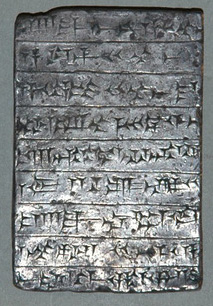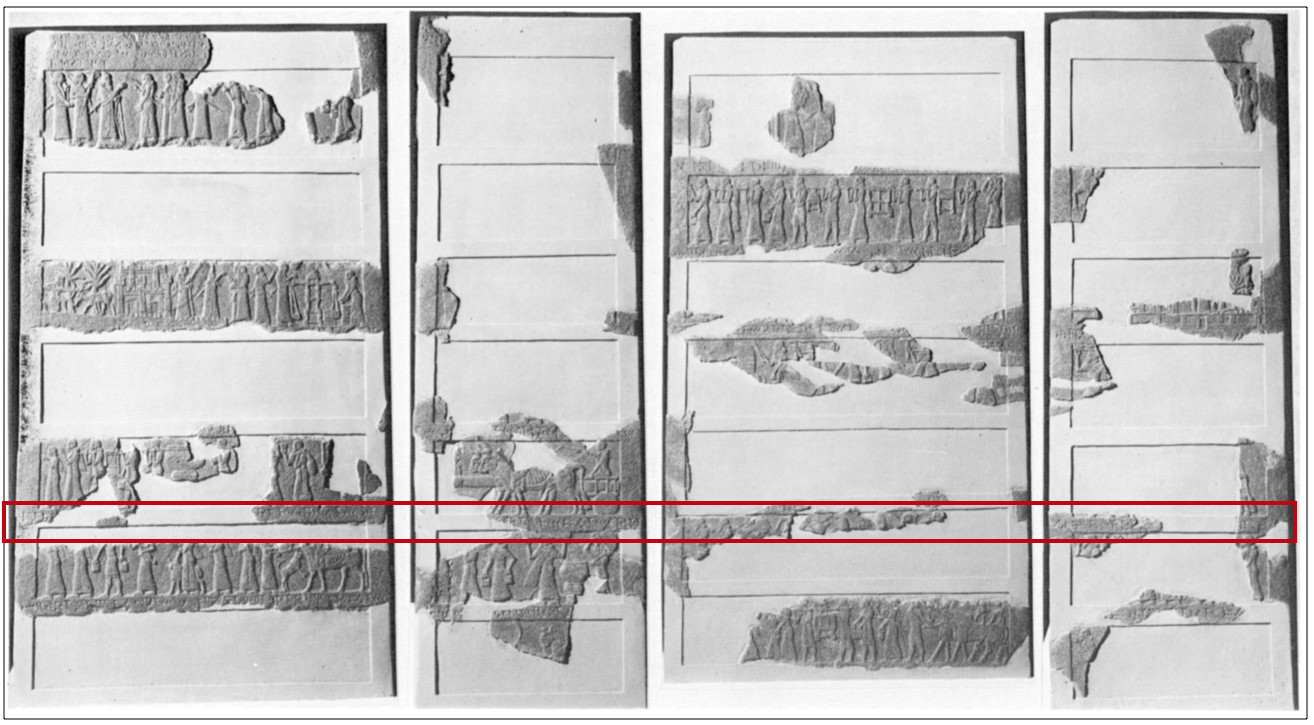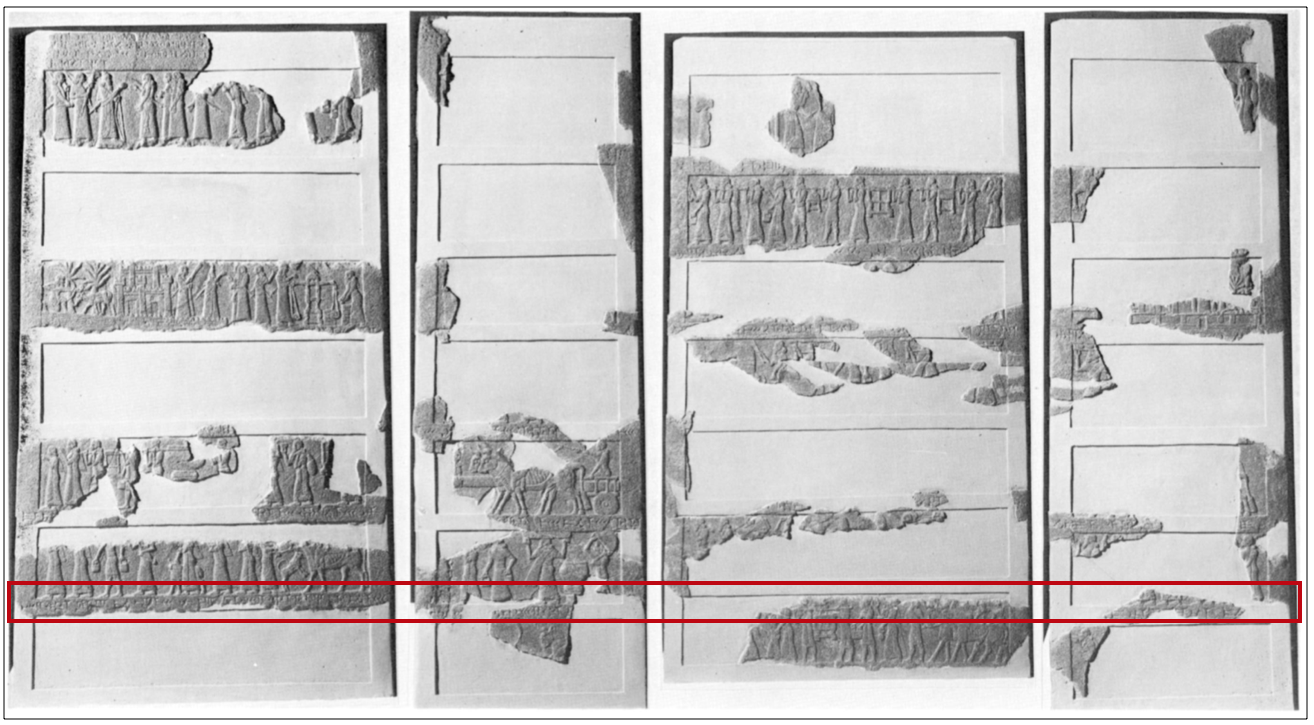Inscriptions, texts nos. 60-79
Browse the RIA 4 Corpus [/riao/ria4/pager/]
60 61 62 63 64 65 66 67 68 69 70 71 72 73 74 75 76 77 78 79
60
This text is preserved on a small fragment of clay cone, measuring just 4 x 4.7 cm. The object was found at Nineveh and the text details Aššurnasirpal II's work on the Ištar temple in that city. As very little of the text has survived, no translation is given here. For more information on this monarch's reconstruction of the Ištar temple, see text no. 56 [/riao/ria4/Q004510/] and its introduction.
Access the composite text [/riao/ria4/Q004514/] of Ashurnasirpal II 60.
Bibliography
61
This text is preserved on one fragment of clay cone, measuring 6.4 x 7.2 cm. The object was found at Nineveh and the text describes Aššurnasirpal II's work on the Ištar temple in that city. As very little of the text has survived, no translation is given here. For more information on this monarch's reconstruction of the Ištar temple, see text no. 56 [/riao/ria4/Q004510/] and its introduction.
Access the composite text [/riao/ria4/Q004515/] of Ashurnasirpal II 61.
Bibliography
62
This text is preserved on one 4.1 x 7.2 cm piece of clay cone, found at the Ištar temple in Nineveh. As so little of the text has survived, no translation is given here. For more information on this monarch's involvement with the Ištar temple, see text no. 56 [/riao/ria4/Q004510/] and its introduction.
Access the composite text [/riao/ria4/Q004516/] of Ashurnasirpal II 62.
Bibliography
63
This text is preserved on one fragment of clay cone, measuring just 4.9 x 4.2 cm. The object was found at the Ištar temple in Nineveh and its inscription seems to describe Aššurnasirpal II's building work there. So little of the text survives, however, that no translation is given here. For more information on this monarch's reconstruction of the Ištar temple, see text no. 56 [/riao/ria4/Q004510/] and its introduction.
Access the composite text [/riao/ria4/Q004517/] of Ashurnasirpal II 63.
Bibliography
64
This small fragment of clay cone, measuring 5.6 x 6.6 cm, bears an inscription concerning building work on the Ištar temple in Nineveh. The object itself was found at Nineveh. No translation is given here because so little of the text survives. For more information on this monarch's reconstruction of the Ištar temple, see text no. 56 [/riao/ria4/Q004510/] and its introduction.
Access the composite text [/riao/ria4/Q004518/] of Ashurnasirpal II 64.
Bibliography
65
This text is partially preserved on one fragment of clay cone, which measures 8.1 x 6+ cm and was found at Nineveh. As in text no. 58 of this monarch, Aššur-rabi II [/riao//ria3/ashurrabiii/index.html] is mentioned as previous builder. This strongly suggests that the text is to be attributed to the reign of Aššurnasirpal II and refers to his work on Bīt-natḫi. For more information on Aššurnasirpal II's reconstruction of the Ištar temple, see text no. 56 [/riao/ria4/Q004510/] and its introduction.
Access the composite text [/riao/ria4/Q004519/] of Ashurnasirpal II 65.
Bibliography
66
Numerous fragments of clay cones from Nineveh (see introduction to text no. 56) are inscribed with a text recording works carried on the Adad temple. Beside name and titles, the text includes a general description of conquests and the build section, which is however badly broken.
Access the composite text [/riao/ria4/Q004520/] of Ashurnasirpal II 66.
Bibliography
67
A dozen (none of theme complete) of clay cones from Ashur are inscribed with a text recording the reconstruction of the Sîn-Šamaš temple. The text, beside name and titles, includes a general description of the king's conquests that has no exact parallels elsewhere in the corpus of this ruler (and therefore its reconstruciton may not be accurate), and the record of the works on the temple.
Access the composite text [/riao/ria4/Q004521/] of Ashurnasirpal II 67.
Bibliography
68
One piece of clay cone foud at Ashur is inscribed with this very fragmentary text, which for what it survives, is a duplicate of the so-called "Standard Inscription" (text no. 23).
Access the composite text [/riao/ria4/Q004522/] of Ashurnasirpal II 68.
Bibliography
69
A piece of clay cone from Ashur is inscribed with a fragmentary text that looks like an abbreviated version of text no. 67.
Access the composite text [/riao/ria4/Q004523/] of Ashurnasirpal II 69.
Bibliography
70

YBC 02399 © Yale Babylonian Collection
A tablet of gold and one of silver coming from the city Apqu (Apqu
ša Adad, mod. Tell Abu Marya) bear this text, which records the
building of a palace in the same provincial centre where also
Aššur-rēša-iši (text no. 10 [/riao/ria2/ashurreshaishii/texts114/index.html#ashurreshaishi110]) built a palace. The stone foundation box
found in the same city (text no. 54) could resonably be the original
storage palce of these two tablets.
Grayson (RIMA 2, p. 341) notes odd sign forms, grammatical slips and
stilted phraseology that he ascribes to scarce capacities on behalf of
the provincial scribe.
Access the composite text [/riao/ria4/Q004524/] of Ashurnasirpal II 70.
Bibliography
71-78: Captions from the "Rassam Obelisk"

BM 090925 + BM 118800 + BM 132013 (from Reade (and Walker), Iraq 42 Pl. I) © The Trustees of the British Museum
71

Reade (and Walker), Iraq 42, Pl. II © The Trustees of the British Museum
This text is a brief caption on the Rassam Obelisk (for more on this object see the introduction to text no. 24 [/riao/ria4/Q004478/]). The part of the line that was presumably intended to list the items received and name the tributary seems to have been left blank. This reinforces the notion that the obelisk was never completed.
Access the composite text [/riao/ria4/Q004525/] of Ashurnasirpal II 71.
Bibliography
72
This text is a brief caption (no. 2) on the Rassam Obelisk (for more on this object see the introduction to text no. 24 [/riao/ria4/Q004478/]). Unfortunately, this caption is far too poorly preserved to identify any particular signs and therefore no edition is given here. As a result, the identity of the tributary remains unclear.
Access the composite text [/riao/ria4/Q004526/] of Ashurnasirpal II 72.
Bibliography
73

Reade (and Walker), Iraq 42, Pl. III © The Trustees of the British Museum
This text is a caption (no. 3) on the Rassam Obelisk (for more on this object see the introduction to text no. 24 [/riao/ria4/Q004478/]). Although the name of the tributary does not survive, Reade suggests that it may be the land Patinu. He bases his argument on the mention of "female musicians." It is attested in text no. 1 [/riao/ria4/Q004455/] (iii 72-76) that the king of Patinu dedicated 10 such individuals to Aššurnasirpal II.
Access the composite text [/riao/ria4/Q004527/] of Ashurnasirpal II 73.
Bibliography
74
This text is a caption (no. 4) on the Rassam Obelisk (for more on this object see the introduction to text no. 24 [/riao/ria4/Q004478/]). The list of objects received survives relatively well, unfortunately the name of the tributary itself is missing.
Access the composite text [/riao/ria4/Q004528/] of Ashurnasirpal II 74.
Bibliography
75
This text is a caption (no. 5) on the Rassam Obelisk (for more on this object see the introduction to text no. 24 [/riao/ria4/Q004478/]). The list of objects received survives relatively well, unfortunately the name of the tributary itself is missing.
Access the composite text [/riao/ria4/Q004529/] of Ashurnasirpal II 75.
Bibliography
76

Reade (and Walker), Iraq 42, Pl. I © The Trustees of the British Museum
This text is a caption (no. 6) on the Rassam Obelisk (for more on this object see the introduction to text no. 24 [/riao/ria4/Q004478/]). Unfortunately the name of the tributary is broken, although the list of items received survives fairly well.
Access the composite text [/riao/ria4/Q004530/] of Ashurnasirpal II 76.
Bibliography
77

Reade (and Walker), Iraq 42, Pl. I © The Trustees of the British Museum
This text is a caption (no. 7) on the Rassam Obelisk (for more on this object see the introduction to text no. 24 [/riao/ria4/Q004478/]). The name of the tributary does not survive, however the detail that they dedicated a herd of elephants and a herd of oxen survives. Reade has speculated as to where these animals may have come from (see bibliography).
Access the composite text [/riao/ria4/Q004531/] of Ashurnasirpal II 77.
Bibliography
78
This text is a caption (no. 8) on the Rassam Obelisk (for more on this object see the introduction to text no. 24 [/riao/ria4/Q004478/]). Unfortunately this inscription is too poorly preserved for an edition.
Access the composite text [/riao/ria4/Q004532/] of Ashurnasirpal II 78.
Bibliography
79
A small piece of stone obelisk bears the following epigraph. Two faces of the obelisk survive and the inscription is preserved on both, as are two panels of reliefs depicting tribute bearers. The text in positioned between the panels. The object itself was found at Nineveh by Campbell Thompson and its current location is unknown. Although it cannot be attributed to Aššurnasirpal II with complete certainty, it seems very likely that it belongs to the reign of this monarch.
Access the composite text [/riao/ria4/Q004533/] of Ashurnasirpal II 79.
Bibliography
Nathan Morello & Poppy Tushingham
Nathan Morello & Poppy Tushingham, 'Inscriptions, texts nos. 60-79', RIA 4: Inscriptions of Ashurnasirpal II, The RIA Project, 2023 [http://oracc.org/inscriptions/texts6079/]